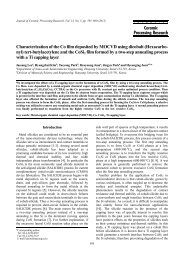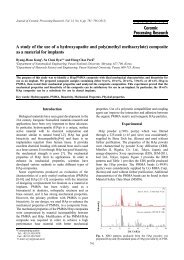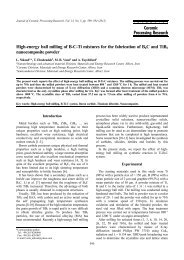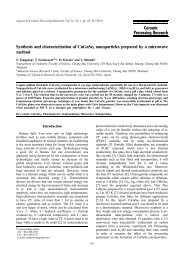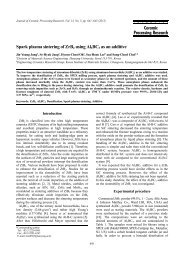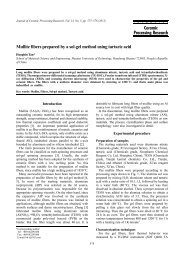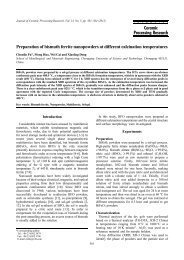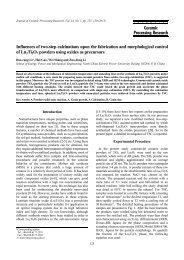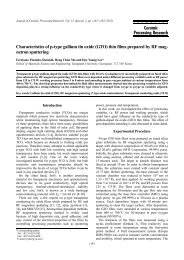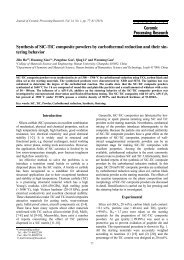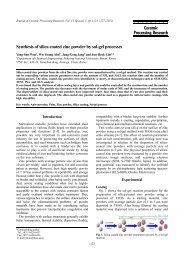Preparation and sintering behavior of Al2O3-Y2O3/ZrB2 composite ...
Preparation and sintering behavior of Al2O3-Y2O3/ZrB2 composite ...
Preparation and sintering behavior of Al2O3-Y2O3/ZrB2 composite ...
Create successful ePaper yourself
Turn your PDF publications into a flip-book with our unique Google optimized e-Paper software.
<strong>Preparation</strong> <strong>and</strong> <strong>sintering</strong> <strong>behavior</strong> <strong>of</strong> Al 2 O 3 -Y 2 O 3 /ZrB 2 <strong>composite</strong> powders 603<br />
Results <strong>and</strong> Discussion<br />
Influence <strong>of</strong> pH on the microstructure <strong>of</strong> Al(OH) 3 -<br />
Y(OH) 3 /ZrB 2 <strong>composite</strong> powders<br />
Al(OH) 3 -Y(OH) 3 /ZrB 2 <strong>composite</strong> powders was synthesized<br />
at particular value <strong>of</strong> the pH. The configuration<br />
<strong>of</strong> an original <strong>and</strong> coated ZrB 2 surface is compared in<br />
Fig. 1. A smooth surface is presented on the original ZrB 2<br />
particles. The ZrB 2 surface is coated with a few floccules<br />
<strong>of</strong> Al(OH) 3 precipitate at pH = 7. Because the pH satisfies<br />
the production <strong>of</strong> the Al(OH) 3 precipitates from the<br />
Al(NO 3 ) 3 solution via heterogeneous nucleation, the Al 3+<br />
does not form Al(OH) 3 precipitates completely. However,<br />
a layer <strong>of</strong> symmetrical floccules with Al(OH) 3 <strong>and</strong> Y(OH) 3<br />
precipitates is coated on the ZrB 2 surface at pH = 9,<br />
which is about 150 nm thick. The thickness <strong>of</strong> the coating<br />
layer is decreased at pH = 11. Many small spheroidal masses<br />
remain with the Y(OH) 3 precipitates on the ZrB 2 surfaces.<br />
With an increase in the pH <strong>of</strong> the ZrB 2 suspension, the<br />
entire process from Al(NO 3 ) 3 <strong>and</strong> Y(NO 3 ) 3 solution to<br />
Al(OH) 3 <strong>and</strong> Y(OH) 3 precipitate is shown in four steps: no<br />
deposit, heterogeneous nucleation, homogeneous nucleation,<br />
<strong>and</strong> a complete deposit [14]. The relationship <strong>of</strong> the<br />
Al 3+ complex <strong>and</strong> pH is shown in Fig. 2. After the complete<br />
deposition process, Al(OH) 3 is formed as an AlO 2 soluble<br />
complex in the suspension <strong>of</strong> ZrB 2 by a continuous<br />
increase <strong>of</strong> the pH [15]. However, Y(OH) 3 precipitates do<br />
not dissolve in the alkaline solution, which still exist on<br />
the ZrB 2 surface. When the pH is 9, Al(OH) 3 -Y(OH) 3 /ZrB 2<br />
<strong>composite</strong> powders with a better coating quality are formed.<br />
Charactorization <strong>of</strong> Al 2 O 3 -Y 2 O 3 /ZrB 2 <strong>composite</strong><br />
powders<br />
Phase analysis <strong>of</strong> ZrB 2 particles is shown in Fig. 3, which<br />
Fig. 1. Topographic characteristics <strong>of</strong> A1(OH) 3 -Y(OH) 3 /ZrB 2<br />
<strong>composite</strong> powders under different pH conditions (a-Original, b-<br />
pH = 7, c- pH = 9 <strong>and</strong> d- pH = 11).<br />
Fig. 2. Relation <strong>of</strong> Al compounds <strong>and</strong> pH.<br />
Fig. 3. XRD <strong>of</strong> ZrB 2 after treating under different conditons (a-<br />
Original ZrB 2 , b-Coated ZrB 2 with A1(OH) 3 -Y(OH) 3 <strong>and</strong> c-Coated<br />
ZrB 2 with Al 2 O 3 -Y 2 O 3 ).<br />
indicates the main phase is the ZrB 2 phase, but a different<br />
phase is found as the conditions are changed. The<br />
backgrounds <strong>of</strong> Fig. 3(b) <strong>and</strong> (c) are higher than for<br />
Fig. 3(a). Because ZrB 2 particles are coated with amorphous<br />
A1(OH) 3 <strong>and</strong> Y(OH) 3 precipitate, Fig. 3(c) shows the<br />
Al 2 O 3 <strong>and</strong> Y 2 O 3 phases, because A1(OH) 3 <strong>and</strong> Y(OH) 3<br />
were dehydrated.<br />
Elemental identification <strong>and</strong> the shell configuration<br />
<strong>of</strong> ZrB 2 particle surfaces under different conditions are<br />
shown in Fig. 4. The original ZrB 2 particles only show<br />
Zr <strong>and</strong> B, but the surface <strong>of</strong> coated ZrB 2 particles shows<br />
Al <strong>and</strong> Y in addition to Zr <strong>and</strong> B. A1(NO 3 ) 3 <strong>and</strong> Y(NO 3 ) 3<br />
have formed A1(OH) 3 <strong>and</strong> Y(OH) 3 precipitates at pH = 9<br />
coated on the surface <strong>of</strong> ZrB 2 particles through the coprecipitation.<br />
The surface <strong>of</strong> the original ZrB 2 particles<br />
is very smooth (Fig. 4(a)). Coated ZrB 2 particles (dried<br />
at 100 o C) are shown in Fig. 4(b); the surface <strong>of</strong> ZrB 2<br />
particles is coated with a layer <strong>of</strong> floccules <strong>of</strong> A1(OH) 3<br />
<strong>and</strong> Y(OH) 3 precipitates. Coated ZrB 2 particles (calcined<br />
at 600 o C) are shown in Fig. 4(c); the surfaces <strong>of</strong> ZrB 2<br />
particles are not smooth <strong>and</strong> many fine particles are evident.<br />
Fig. 3(c) is the phase analysis <strong>of</strong> <strong>composite</strong> particles<br />
calcined at 600 o C, <strong>and</strong> the background <strong>of</strong> the phase<br />
picture is high, which means the <strong>composite</strong> particles<br />
contain A1(OH) 3 <strong>and</strong> Y(OH) 3 .



